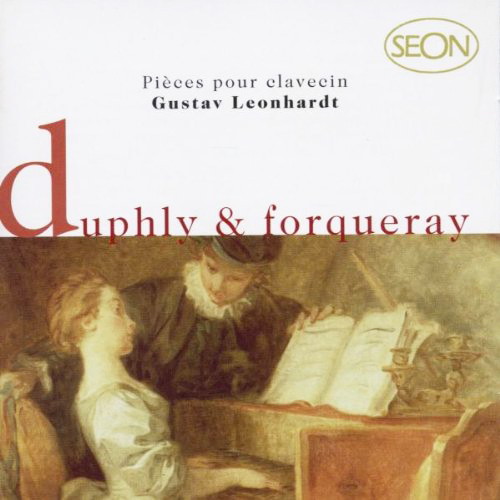
|
1 LP -
6575 017 - (p) 1973
|
 |
| 2 CDs -
SB2K 60875 - (c) 1999 |
|
PIÈCES DE
CLAVECIN
|
|
|
|
|
|
|
|
| Jacques DUPHLY (1715-1789) |
"La
de Belombre" in D Minor (3rd book,
1758) |
|
4' 01" |
A1 |
|
"Les
Grâces" Tendrement in D Major (3rd
book, 1758) |
|
4' 18" |
A2
|
|
"La Damanzy" in D Major (1st
book, 1744) |
|
4' 24" |
A3
|
|
"La
Forqueray" Rondeau in F Minor (3rd
book, 1758) |
|
6' 11" |
A4 |
|
"La
Pothoüin" in C Minor (4th book,
1768) |
|
6' 07" |
A5 |
|
"Allemande
- Courante" in D Minor (1st book,
1744)
|
|
7' 46" |
B1 |
|
"Menuets"
in D Major (3rd book, 1758) |
|
3' 43" |
B2 |
|
"La
Damanzy" Vivement in A Major (2nd
book, 1748) |
|
3' 16" |
B3 |
|
"La
Felix" Noblement in D Minor (2nd
book, 1748) |
|
3' 53" |
B4 |
|
"Chaconne"
in F Major (3rd book, 1758)
|
|
7' 39" |
B5 |
|
|
|
|
|
| Gustav
Leonhardt, Harpsichord by David Rubio,
Oxford, 1972 after Pascal Taskin
(1723-1793) - Tuning: 1/2 tone below
normal |
|
|
|
|
|
Luogo
e data di registrazione |
|
Doopsgezinde Kerk,
Amsterdam (Holland) - Gennaio 1973
|
|
|
Registrazione:
live / studio |
|
studio |
|
|
Producer /
Recording Supervisor |
|
Wolf Erichson
|
|
|
Recording
Engineer
|
|
Dieter Thomsen
|
|
|
Prima Edizione
LP |
|
Seon (Philips) | 6575
017 | 1 LP - durata 51' 38" | (p)
1973 | ANA
|
|
|
Edizione CD |
|
Sony | SB2K 60875 | 2
CDs - durata 51' 38" & 49' 42"
| (c) 1999 | ADD
|
|
|
Original Cover
|
|
-
|
|
|
Note |
|
La riedizione in 2 CD
della Sony contiene: nel primo CD
le musiche di Duphly (Seon Philips
6575 017) e nel secondo CD le
musiche di Forqueray (Seon Philips
6575 038).
|
|
|
|
|
Duphly has few
truths to tell the world -
except that France is a
country unequalled in the
field of decorative art.
Ornamentation is not meant
to be too arresting;
ornamentation should be
pleasant; ornamentation is
necessary where otherwise
boredom would reign. And
Duphly understood exactly
what bored Parisian high
society wanted. He created
music which was not too
difficult for fingers or for
ears. The gentle fingers of
the young ladies, of whom he
was a much sought-after
teacher, found it
comparatively easy to
extract the most touching
tones from the harpsichords
of Blanchet, Vater, and
Taskin, since his pieces
concealed within their notes
the secret of sonority. Such
a style of composition
demands as much expert
knowledge as writing
difficult or bizarre works.
The perfect always seems
easy in the eyes of the
non-initiated.
Duphly, born in 1715 in
Rouen, was a pupil of
Agincourt. He held a number
of posts as an organist
before he went to Paris as a
harpsichordist. He remained
there until his death in
1789, earning his living as
a performing artist. His
pieces, like the
man-himself, were “douces et
aimables” and “affectent
beaucoup le cœur“ [P.L.
Dacquin, 1753]. Yet towards
the end of his life he lost
some of his former
popularity and in the
“Tablettes” he was referred
to - in small letters and
without eulogies - as
“Duphly a fait différentes
Œuvres de pieces détachées
pour Le Clavecin,” and
was overshadowed by such
great names of the time as
Balbâtre. Eckard, Edelmann,
and Hullemandel.
In the four printed books of
the “Pieces de Clavecin” of
1744, 1748,1758, and 1768,
the final development of
French harpsichord music can
clearly be discerned. The
first book still shows
traces of the dance-suite
tradition (Allemande,
Courante), with groupings of
eight pieces in D and seven
in C. In the second book we
find only character pieces
divided into four key
groups. The third book
presents five key groups,
again with character pieces,
and the last book consists
of a collection of character
pieces without any grouping.
In the final book we are
also confronted with a style
corresponding to the new
ideal of simplicity.
Frequently a simple melody
moves above an accompaniment
of simple broken chords.
Many performers may already
at that time have played
these pieces on the
fortepiano or made use of
the “Peau de Buffle”
register of the most recent
harpsichords. In the printed
copy from the private
collection of Lord
Fitzwilliam we find Duphly’s
handwritten directions,
particularly with regard to
fingering. He is one of the
first to suggest modern
legato scale-fingering with
the thumb passing under. In
other ways too the
directions aim at the
flowing, flexible, soft, and
light style of playing which
has been hailed as a French
speciality.
The “Delicate Duphly” can
still be enjoyed and admired
by us today. The music may
be the embodiment of a not
altogether too high ideal,
yet it is, in its own way,
still perfect.
Gustav
Leonhardt
|
  |
|
|